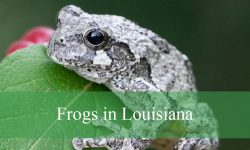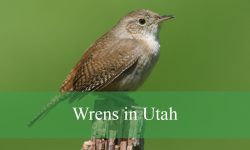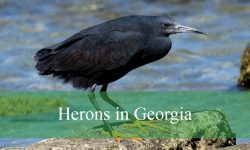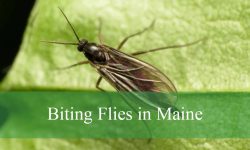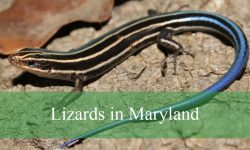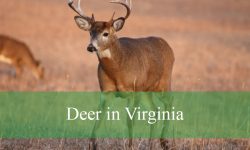Exploring the animal kingdom through the lens of animals that share the same starting letter is a fascinating way to discover new species. Animals that start with N offer a wide range of creatures, from majestic mammals to incredible insects and marine life. If you’re a wildlife enthusiast or simply curious, this list of animals that start with N will introduce you to some truly unique and remarkable species.
In this article, we’ll take you through 60 animals that begin with the letter “N.” Found across various habitats—from the icy waters of the North Pole to the lush jungles of Africa—these animals each have distinct features, behaviors, and important roles in their ecosystems. So, if you’re ready to learn about some amazing creatures, keep reading to discover the world of animals that start with N.
We’ve also included pictures to give you a better understanding of what each animal looks like. Whether you’re learning for fun or out of curiosity, the beauty and diversity of animals that start with N will surely captivate you. Let’s dive in and get to know these fascinating species!
List of Animals That Start With N
Narwhal

The narwhal is a unique marine mammal known for its long, spiral tusk that can grow up to 10 feet long. This tusk is actually an elongated upper-left canine tooth, most commonly seen in males. Narwhals have a mottled grayish-blue skin and can grow to lengths of around 13 to 18 feet, weighing nearly 3,500 pounds.
Narwhals inhabit Arctic waters around Canada, Greenland, Norway, and Russia. They are deep-diving whales that spend much of their time under ice-covered waters. Narwhals prefer cold, coastal environments where they can navigate narrow fjords and open sea ice leads.
Their diet consists mainly of Greenland halibut, squid, shrimp, and Arctic cod. Narwhals are known for their elusive behavior and deep diving capabilities, plunging up to 5,000 feet below the surface. One fun fact is that the narwhal’s tusk contains millions of nerve endings, and scientists believe it may be used to sense changes in the environment.
Nutria (Coypu)
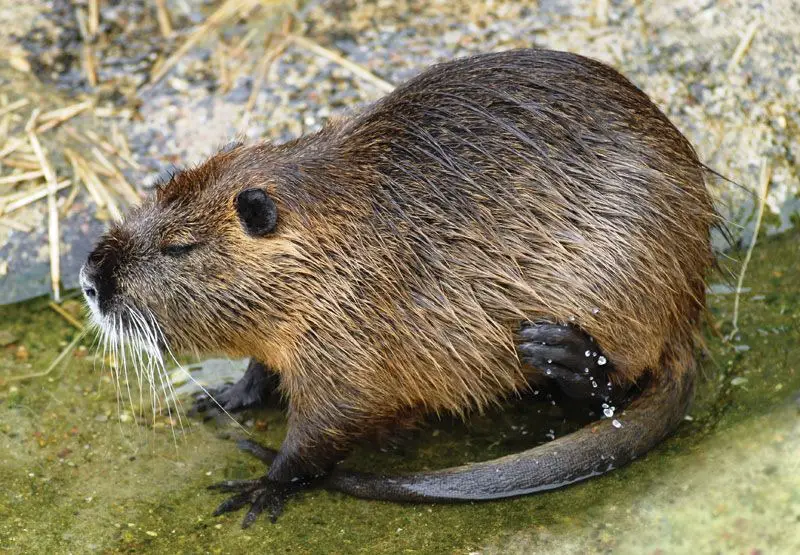
The nutria, also known as coypu, is a large, semi-aquatic rodent with a robust body, webbed hind feet, and long orange-yellow incisors. It resembles a beaver or muskrat but can be distinguished by its long, rounded tail. Adult nutrias weigh around 10 to 20 pounds and can grow up to 2 feet in body length.
Originally native to South America, nutria have become an invasive species in parts of North America, Europe, and Asia. They live in wetlands, rivers, lakes, and marshes, where they dig burrows and build nests among vegetation. Their burrowing behavior often causes erosion and damages water control structures.
Nutria are herbivores that feed on aquatic plants, roots, rhizomes, and crops. They are mostly nocturnal and known for their rapid reproduction. A fun fact about nutria is that they can hold their breath for up to five minutes underwater, making them highly adapted to life in aquatic environments.
Northern Fur Seal
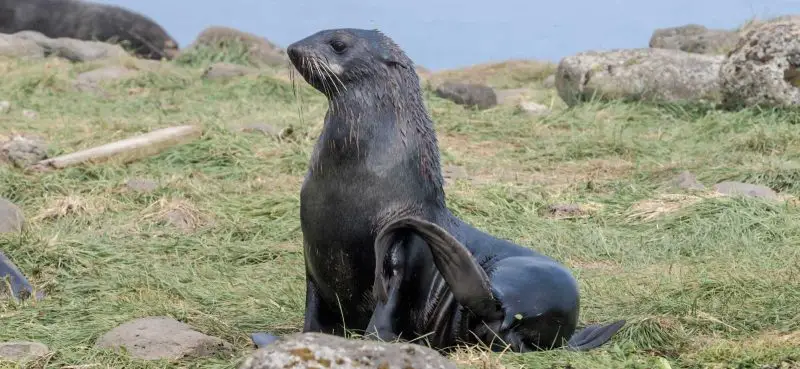
The northern fur seal is a marine mammal with dense, luxurious fur that helps insulate it from cold ocean temperatures. Males are significantly larger than females, reaching up to 600 pounds and 7 feet in length, while females typically weigh less than 150 pounds. They have a pointed snout, large flippers, and thick underfur covered by coarse guard hairs.
These seals inhabit the North Pacific Ocean and breed primarily on islands like the Pribilof Islands in Alaska. They spend most of the year at sea, traveling thousands of miles and hauling out only to breed and give birth. Northern fur seals prefer cold, nutrient-rich waters teeming with fish.
They primarily eat squid, fish such as pollock and anchovy, and other small marine organisms. Northern fur seals are agile swimmers and can dive to depths of 600 feet in search of food. One interesting fact is that their fur is so thick it has over 300,000 hairs per square inch, among the densest of any mammal.
Numbat

The numbat is a small, colorful marsupial native to Australia, recognizable by its reddish-brown coat, white stripes across the back, and long bushy tail. It has a slender snout and a sticky tongue used for eating termites. Adults weigh less than one pound and are about 9 inches long, not including the tail.
Numbats live in eucalyptus forests and woodlands, especially where there’s plenty of fallen timber. They require habitats with a healthy termite population and use hollow logs and burrows for shelter. Unlike many marsupials, numbats are diurnal, meaning they are active during the day.
They feed exclusively on termites, consuming up to 20,000 each day. Numbats are solitary animals with a keen sense of smell to detect termites underground. A fascinating fact is that numbats don’t have a functional pouch; instead, the young cling to the mother’s belly fur after birth.
Nilgai

The nilgai, often called the blue bull, is the largest antelope in India. Males are a bluish-gray color with short horns, while females are more brownish and hornless. Nilgai can grow up to 5 feet tall at the shoulder and weigh around 400 to 600 pounds, with a sturdy, horse-like build.
They inhabit grasslands, scrub forests, and agricultural fields throughout the Indian subcontinent. Nilgai prefer open terrain with sparse tree cover and are often seen in groups, although older males may be solitary. They are mostly diurnal and tend to be shy around humans.
Nilgai feed on grasses, leaves, and crops, making them a nuisance to farmers in some regions. They are swift runners and can leap fences when threatened. A fun fact: despite their large size and antelope classification, nilgai are more closely related to cattle than to deer.
Naked Mole Rat
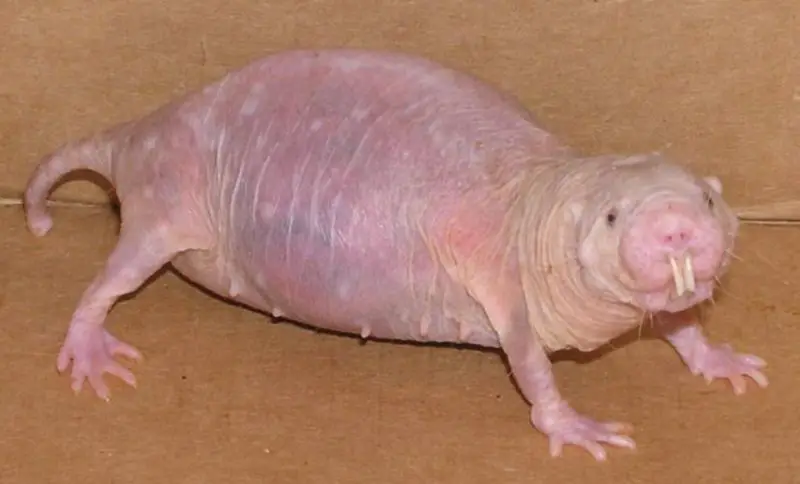
The naked mole rat is a hairless, wrinkly rodent with pink or yellowish skin, small eyes, and large protruding teeth used for digging. These strange-looking creatures grow up to 4 inches long and weigh only a few ounces. Despite their appearance, they are fascinating due to their biological quirks.
They are found in the arid regions of East Africa, particularly in Ethiopia, Kenya, and Somalia. Naked mole rats live underground in complex tunnel systems, forming eusocial colonies similar to those of ants and bees. Each colony has a single breeding queen and non-reproductive workers and soldiers.
Their diet consists mainly of underground tubers and roots. They are nearly blind, insensitive to pain, and highly resistant to cancer. One amazing fact is that naked mole rats can survive without oxygen for up to 18 minutes, making them one of the most hypoxia-tolerant mammals on Earth.
North American Beaver

The North American beaver is a large, semi-aquatic rodent known for its broad, flat tail and powerful teeth used to fell trees. Adults typically weigh between 30 to 70 pounds and have dense brown fur that provides insulation. Their incisors never stop growing and are self-sharpening due to their constant gnawing on wood.
Beavers are found throughout the United States and Canada, typically near freshwater environments like rivers, lakes, streams, and ponds. They are famous for building dams, canals, and lodges, which provide protection from predators and access to food during winter months. Their constructions significantly influence local ecosystems, often creating wetland habitats.
They are herbivores that feed on bark, twigs, aquatic plants, and tree leaves, especially from willow, aspen, and birch trees. Beavers are mostly nocturnal and extremely territorial. A fascinating fact is that beaver dams can be seen from space—one in Alberta, Canada stretches over 2,700 feet long.
North American Porcupine

The North American porcupine is a slow-moving rodent covered in around 30,000 sharp quills that serve as a defense against predators. It has a stout body, small head, and a bushy tail, and can weigh between 12 to 35 pounds. Its quills are loosely attached and can embed easily into attackers.
This porcupine inhabits forests, tundra, and shrublands across Canada, Alaska, and the northern and western United States. It is a solitary, mostly nocturnal animal and spends much of its time in trees. Porcupines are good climbers and often rest high in tree branches during the day.
They primarily eat bark, leaves, twigs, and green plants. In winter, they rely heavily on the inner bark of trees like pine and hemlock. One interesting fact is that porcupines have a strong odor due to a chemical in their skin that helps repel predators and alert others to their presence.
New Guinea Singing Dog
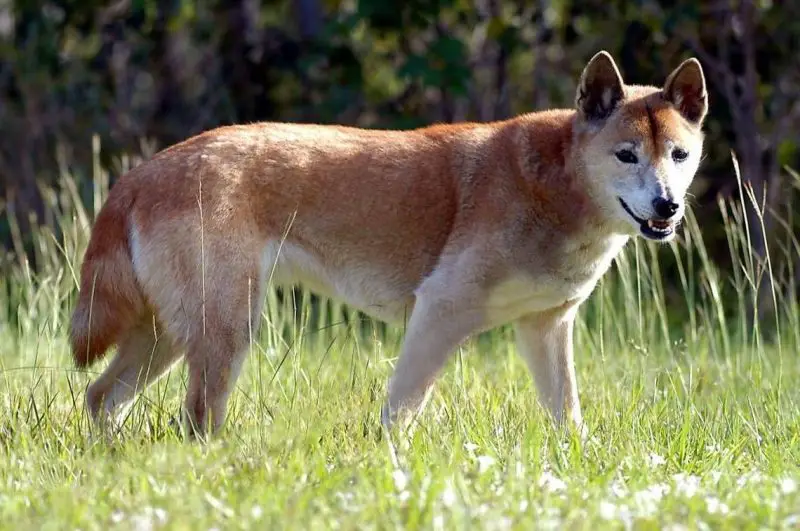
The New Guinea singing dog is a rare, primitive canid known for its unique and melodious howls that sound like singing. It has a fox-like appearance with a slender body, erect ears, and a reddish-brown coat often accented with white markings. They are agile and incredibly flexible, capable of climbing and squeezing through tight spaces.
They originate from the highlands of New Guinea, where they live in dense forests and mountainous terrain. Once thought extinct in the wild, some small populations have been rediscovered. Most known individuals today live in conservation centers and zoos.
These dogs are carnivorous, feeding on small mammals, birds, and reptiles. They are elusive and generally avoid human contact. A fascinating fact is that their vocalizations consist of harmonic tones unlike those of any other canid, giving them their “singing” name.
Norwegian Elkhound
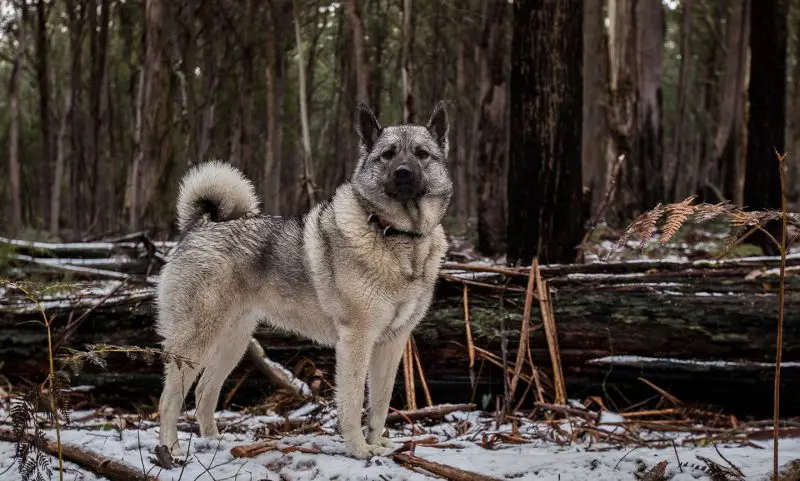
The Norwegian Elkhound is a sturdy, medium-sized dog breed with a thick, silver-gray coat and a curled tail. It has pricked ears, dark eyes, and a confident expression. Originally bred for hunting moose and other large game, this breed is strong, courageous, and highly energetic.
It originates from Norway and has a history dating back thousands of years, being one of the oldest dog breeds in Scandinavia. Norwegian Elkhounds are well-suited to cold climates and mountainous terrain. They were traditionally used not only for hunting but also as guard dogs and loyal companions.
This breed thrives on high-protein diets and requires plenty of exercise to stay healthy. Elkhounds are intelligent, alert, and independent, making training both rewarding and challenging. One fun fact: these dogs were used by the Vikings and often appear in Norse legends and folklore.
Newfoundland

The Newfoundland is a giant working dog breed known for its sweet nature, massive size, and impressive swimming ability. Males often weigh between 130 to 150 pounds, with a thick, water-resistant double coat that helps them in cold waters. They have webbed feet, a powerful build, and a gentle expression.
This breed hails from the Canadian island of Newfoundland, where it was developed to assist fishermen. Newfoundlands were used for water rescues, pulling nets, and hauling loads. They are natural swimmers and can perform lifesaving tasks even in rough seas.
They eat a well-balanced diet suitable for large breeds and benefit from regular exercise and grooming. Newfoundlands are affectionate, calm, and great with children. An interesting fact is that they have been credited with saving many lives from drowning, thanks to their strength and bravery in the water.
Neapolitan Mastiff

The Neapolitan Mastiff is a massive, muscular dog breed known for its loose, wrinkled skin and imposing appearance. It can weigh over 150 pounds and has a short, dense coat that comes in colors like gray, black, and mahogany. Its droopy face and large jowls give it a distinctive look.
This breed originated in southern Italy and was traditionally used as a guard dog. It was bred to protect homes, estates, and livestock, relying on its sheer size and intimidating presence to deter intruders. Neapolitan Mastiffs are loyal and protective, forming strong bonds with their families.
They require a nutritious diet to support their large frames and benefit from early training and socialization. While calm and laid-back at home, they are wary of strangers and make excellent watchdogs. A fun fact: despite their tough exterior, these dogs are known to be very gentle with children and loved ones.
Northern Right Whale
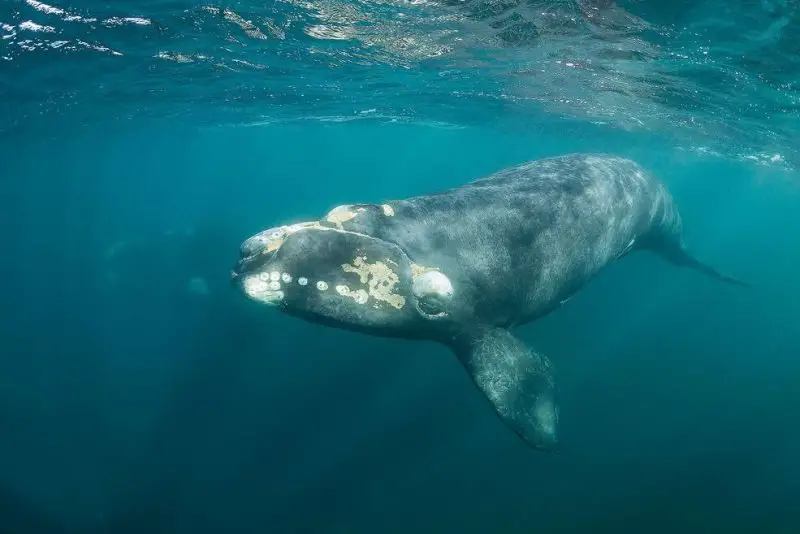
The Northern right whale is a massive baleen whale that can grow up to 52 feet long and weigh around 140,000 pounds. It has a dark gray to black body with rough patches of skin called callosities on its head, which are unique to each individual. Unlike many other whales, it has no dorsal fin and possesses long, arching mouths lined with baleen plates used to filter feed.
These whales inhabit the Atlantic Ocean, primarily along the east coast of North America. They migrate seasonally between feeding grounds in the north and calving grounds off the southeastern United States. Northern right whales prefer shallow coastal waters but are also found in deeper offshore regions during migration.
They primarily feed on tiny zooplankton and krill by swimming with their mouths open to strain food from the water. Northern right whales are slow swimmers and surface often, making them vulnerable to ship strikes and entanglement in fishing gear. A concerning fact is that this species is critically endangered, with fewer than 400 individuals remaining.
Nyala
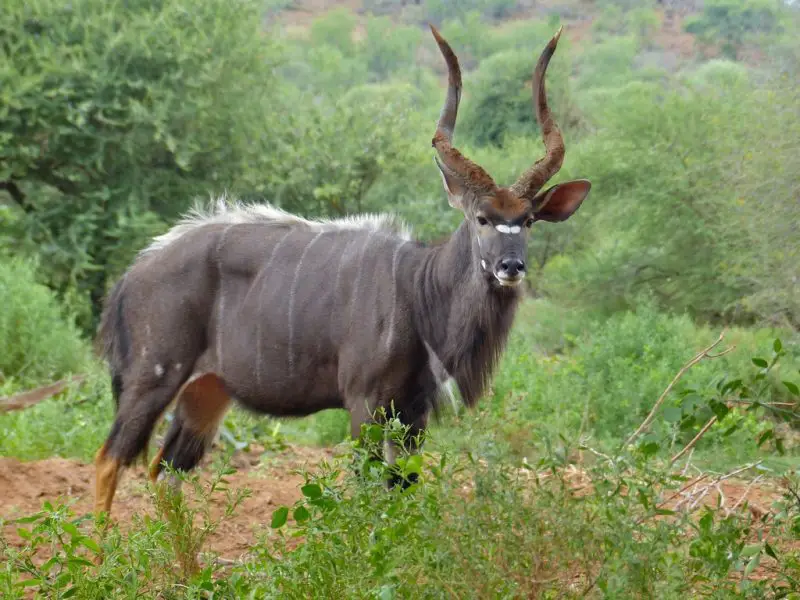
The nyala is a medium-sized antelope native to southern Africa, easily recognized by its spiral horns (in males), white stripes along the body, and shaggy coat. Males are much larger than females and have a slate-gray coloration, while females and juveniles are reddish-brown. Both sexes have a white chevron between their eyes and white markings on their sides and legs.
Nyalas are typically found in dense woodlands, thickets, and areas near water in countries like Mozambique, Zimbabwe, and South Africa. They are shy and elusive animals, preferring to stay hidden in vegetation and emerging during early morning or late afternoon hours.
They feed on leaves, twigs, fruits, and grasses, making them both browsers and grazers depending on the season. Nyalas are non-territorial and live in loosely structured groups, with males often leading solitary lives. A fascinating fact is that males use a slow, high-stepping walk called “feather displays” to assert dominance without physical fighting.
Northern Raccoon

The Northern raccoon is a medium-sized mammal with a bushy, ringed tail and a distinctive black “mask” of fur around its eyes. It weighs between 8 to 20 pounds and has dexterous front paws that it uses to manipulate food and open containers. Its fur is typically grayish-brown, and its appearance is easily recognizable.
Raccoons are native to North America and are highly adaptable, living in forests, wetlands, suburbs, and cities. They make dens in hollow trees, abandoned buildings, attics, or burrows and are primarily nocturnal, foraging at night and sleeping during the day.
Their diet is omnivorous and includes fruits, nuts, insects, small animals, eggs, and human food scraps. Raccoons are known for their intelligence and problem-solving skills, often figuring out how to open latches or steal pet food. An interesting fact is that raccoons often “wash” their food in water, a behavior thought to enhance their tactile experience rather than clean the food.
Nightjar

The nightjar is a nocturnal bird with a slender body, long wings, and cryptic plumage that blends into bark and leaf litter. It has a short bill but a wide mouth adapted for catching insects in flight. Most nightjars are brown, gray, and mottled, making them nearly invisible when roosting on the ground.
These birds are found in open woodlands, grasslands, and scrublands around the world, including parts of North and South America, Europe, Asia, and Africa. They are crepuscular and nocturnal, becoming active at dusk to hunt flying insects like moths and beetles.
Nightjars do not build nests but instead lay their eggs directly on the ground. Their soft, eerie calls and silent flight have given rise to folklore and myths in many cultures. A fun fact is that some nightjars can enter a state of torpor to conserve energy during cold or food-scarce periods.
Nighthawk
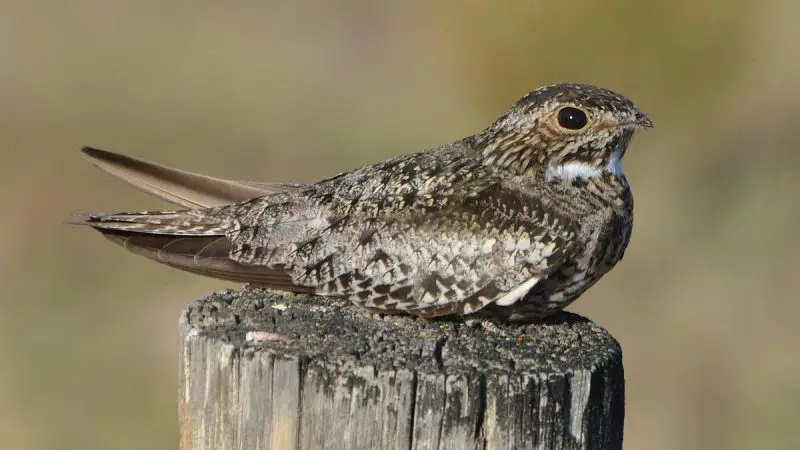
The nighthawk is a medium-sized bird known for its long, pointed wings and erratic flight pattern. It has a mottled brown, black, and white plumage, which provides excellent camouflage during the day. Despite its name, it is not a true hawk but belongs to the nightjar family.
Nighthawks are found throughout North and South America, especially in open habitats such as fields, grasslands, deserts, and even urban areas. They are migratory birds and travel long distances between their breeding grounds in North America and wintering grounds in South America.
They are aerial insectivores, catching insects in flight using their wide mouths. Nighthawks are crepuscular and are most active during twilight hours. A fascinating behavior is their “booming” courtship display, where males dive steeply through the air, producing a loud sound with their wings.
Northern Cardinal
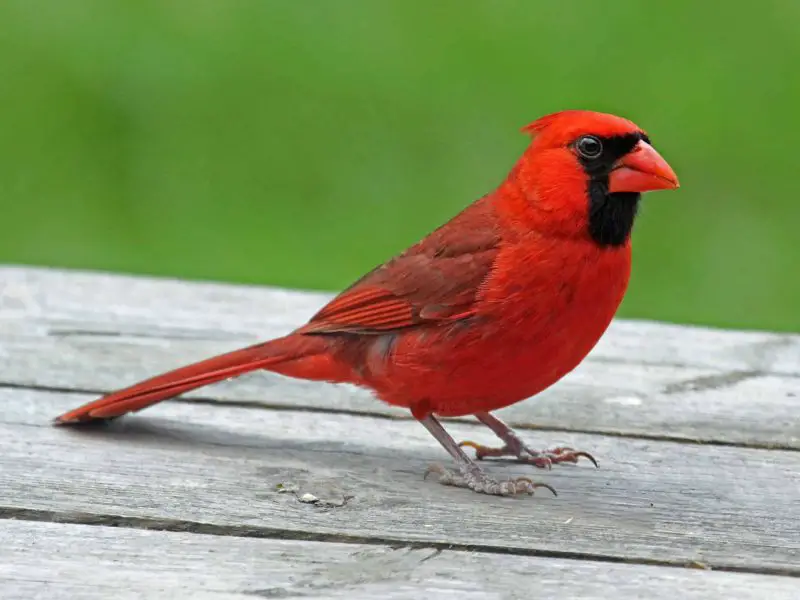
The Northern cardinal is a bright red songbird commonly found throughout the eastern and central United States. Males are a vivid crimson with a black mask around the beak, while females are a warm brown with red tinges. Both sexes have a crest on their heads and a thick, conical bill perfect for seed eating.
They inhabit woodlands, gardens, shrublands, and suburban neighborhoods, often seen perched in trees or foraging on the ground. Cardinals are non-migratory and tend to remain in their territories year-round, even during snowy winters, which adds to their popularity among birdwatchers.
Northern cardinals feed on seeds, fruits, and insects, and they are known for their sweet whistling songs. They are territorial during the breeding season and will even attack their own reflection. A delightful fact is that both males and females sing, which is rare among North American songbirds.
Northern Goshawk
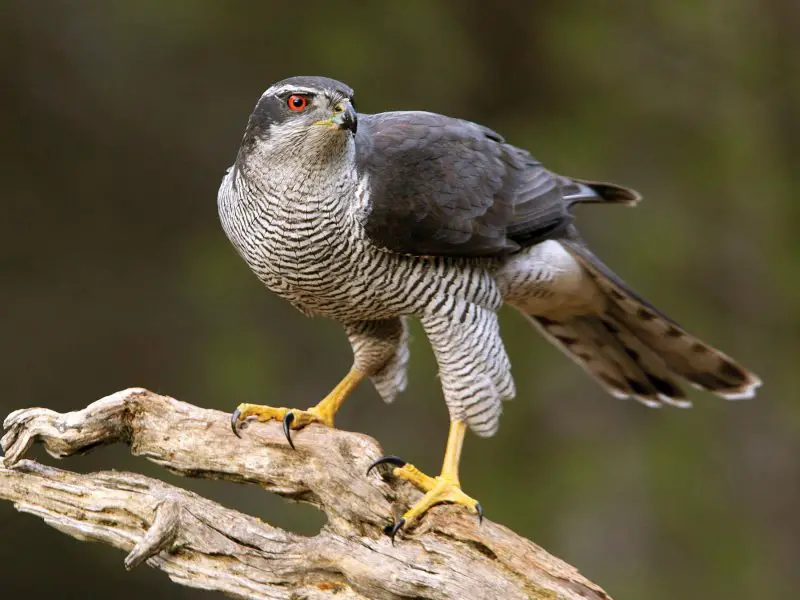
The Northern goshawk is a powerful bird of prey with broad wings, a long tail, and striking red or orange eyes. Adults have slate-gray plumage above and finely barred underparts, while juveniles are brown with streaked bellies. It belongs to the Accipiter genus, known for agile hunters that excel in dense forests.
This raptor inhabits coniferous and mixed woodlands across North America, Europe, and Asia. It prefers remote, mature forests and is rarely seen in urban areas. Northern goshawks are highly territorial and elusive, often staying hidden within the forest canopy.
They prey on birds, squirrels, rabbits, and other small mammals, using stealth and speed to ambush their targets. During breeding season, they build large stick nests high in trees. A remarkable fact about the Northern goshawk is its fierce defense of its nesting area, where it may dive at intruders, including humans.
Northern Flicker
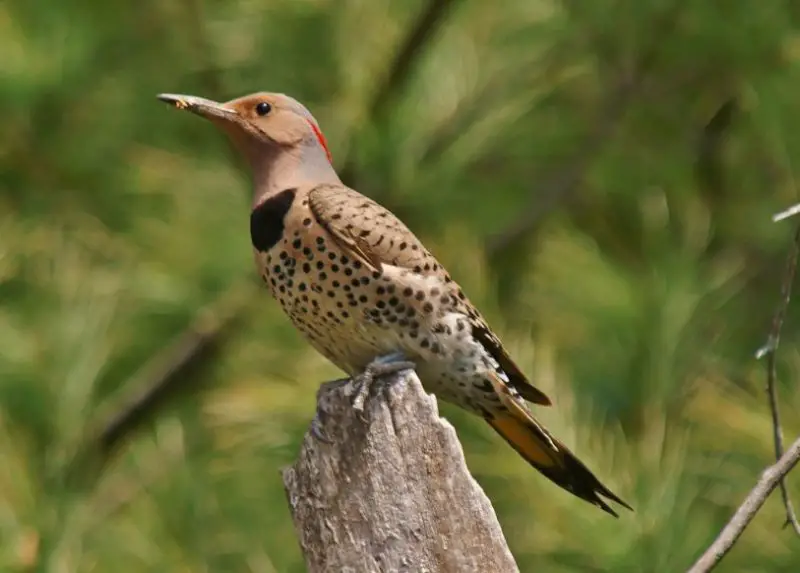
The Northern flicker is a medium-sized woodpecker with a distinctive spotted chest, black crescent mark, and colorful feather highlights. It comes in two main color morphs: the yellow-shafted flicker in the east and the red-shafted flicker in the west. Its call is a loud, ringing “wick-a-wick-a-wick.”
It can be found throughout most of North America in open woodlands, forest edges, parks, and suburban areas. Unlike many woodpeckers, it often forages on the ground, especially in grassy areas where ants and beetles are abundant.
Northern flickers feed primarily on insects, particularly ants, but also eat seeds and berries. They nest in tree cavities and sometimes in artificial nest boxes. An interesting fact is that their tongues are extremely long and sticky, ideal for probing anthills and snagging prey deep in crevices.
Northern Harrier
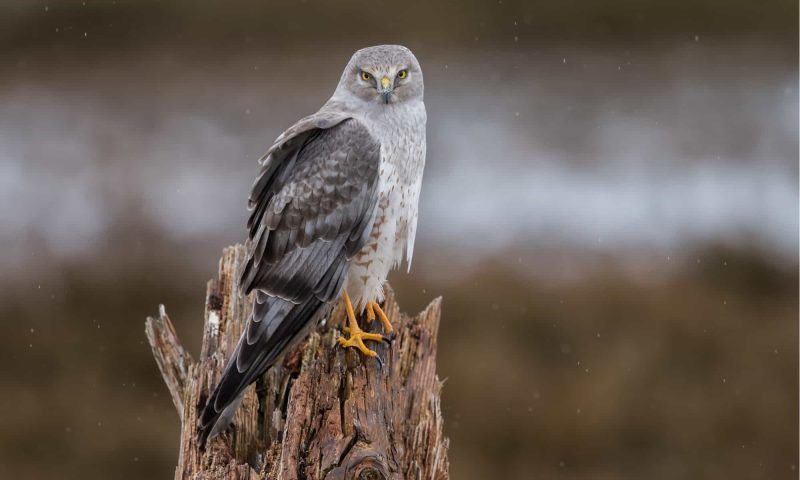
The Northern harrier is a slender raptor recognized by its owl-like face, long wings, and white rump patch. Males are gray above with a lighter underside, while females are brown with streaked underparts. Their facial disc enhances hearing, helping them locate prey in tall grasses.
They inhabit open habitats such as marshes, grasslands, and agricultural fields across North America. Northern harriers are ground-nesting birds and are most often seen gliding low over fields while hunting.
Their diet includes small mammals, birds, and amphibians. Unlike most hawks, they rely heavily on their sense of hearing as well as sight to hunt. A fascinating trait of the Northern harrier is its unique flight style—a buoyant, tilting glide that resembles that of owls or butterflies.
Northern Mockingbird
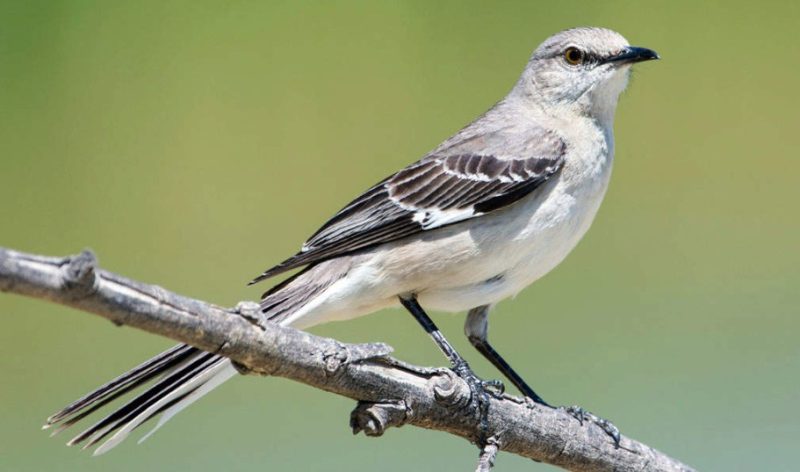
The Northern mockingbird is a medium-sized gray songbird with a long tail, white wing patches, and an upright posture. It is renowned for its vocal abilities, often mimicking the songs of other birds, as well as mechanical noises like car alarms and phones.
This bird thrives in a wide range of habitats including suburbs, parks, open forests, and desert scrub across the United States, Mexico, and parts of Central America. It is non-migratory and fiercely territorial, especially during the breeding season.
Mockingbirds feed on insects during warmer months and switch to fruits and berries in the winter. They are known to sing at all hours, sometimes even at night under a full moon. An amazing fact is that some mockingbirds can learn and remember over 200 different sounds in their lifetime.
Nene (Hawaiian goose)
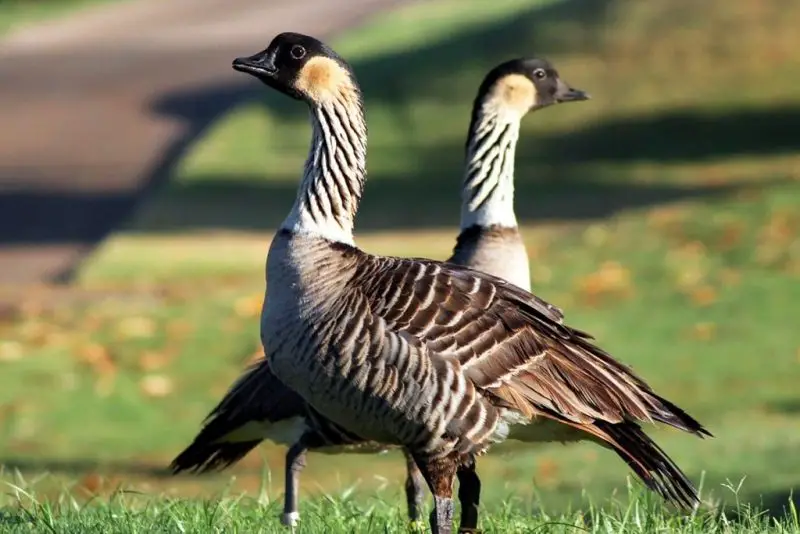
The Nene, or Hawaiian goose, is a medium-sized goose with a buff-colored body, black face, and deeply furrowed neck. It is the state bird of Hawaii and is closely related to the Canada goose. Its feet are adapted for walking on lava flows and rocky terrain rather than swimming.
This species is endemic to the Hawaiian Islands and can be found in grasslands, shrublands, and open volcanic slopes. Nenes have made a slow recovery after near extinction due to hunting and introduced predators like mongooses and cats.
They primarily eat grasses, leaves, berries, and seeds, foraging mostly on land. Nenes are monogamous and form long-term pair bonds. A remarkable fact is that conservation efforts, including captive breeding and reintroduction, have brought their numbers back from fewer than 30 individuals to over 2,500 today.
Nicobar Pigeon

The Nicobar pigeon is a strikingly beautiful bird with iridescent green, blue, and copper plumage and a white tail. It has long neck hackles and a strong, dark beak. This species is the closest living relative to the extinct dodo.
It is native to small islands and coastal regions from the Nicobar Islands (India) to Southeast Asia and the Pacific. Nicobar pigeons prefer dense forests, mangroves, and small islets, where they roost in flocks and feed on the ground.
They eat seeds, fruits, and small invertebrates and often forage in groups. These birds are strong fliers, despite their heavy bodies, and travel between islands in search of food. An intriguing fact is that Nicobar pigeons swallow small stones to help grind food in their gizzards, aiding digestion.
New Zealand Kaka
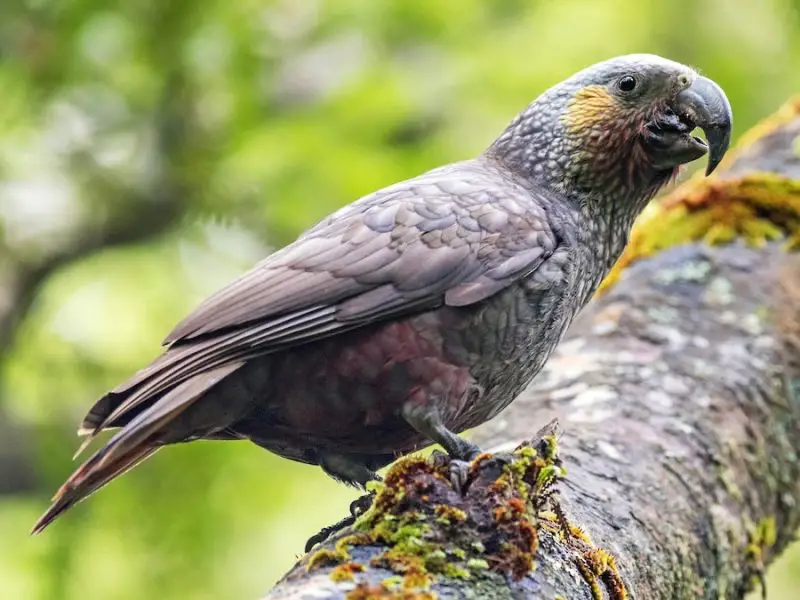
The New Zealand Kaka is a medium-sized parrot with olive-brown feathers, bright orange underwings, and a strong, curved beak. It is part of the Nestor genus, closely related to the Kea, and is known for its intelligence and curiosity. Males are generally larger with a more pronounced beak curve.
This species is native to the forests of New Zealand, particularly in the North Island and parts of the South Island. It lives in lowland and mid-altitude native forests and often nests in tree hollows. The Kaka is mostly arboreal, spending much of its time among tree branches.
Kakas feed on nectar, fruits, seeds, insects, and sap, using their brush-tipped tongues and beaks to extract food. They are known for their loud, screeching calls and playful antics. A fun fact is that the Kaka’s population is increasing in urban areas like Wellington due to successful conservation and predator control programs.
New Zealand Falcon
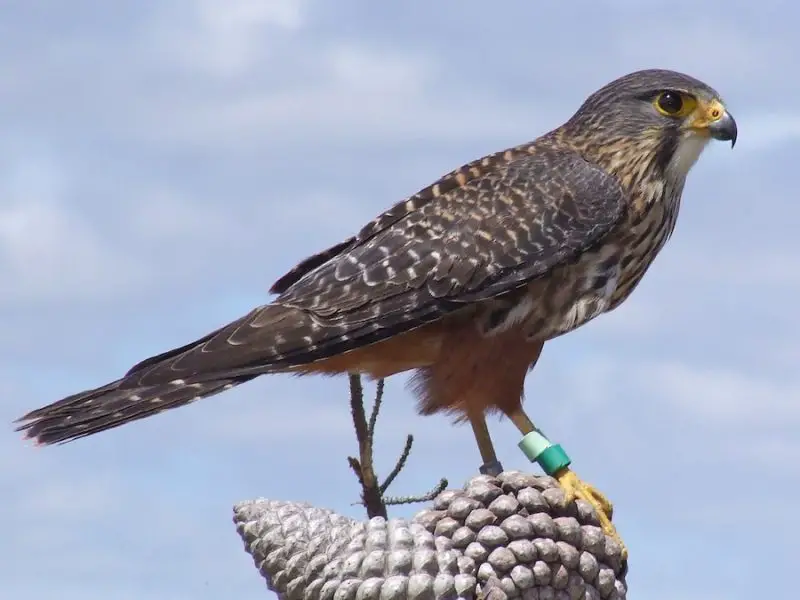
The New Zealand Falcon, or Kārearea, is a swift and powerful raptor with a dark brown back, pale underparts, and sharp talons. It is smaller than other falcons but known for its aggressive and fearless nature. This bird has keen eyesight and flies with sharp, fast wingbeats.
It is endemic to New Zealand and can be found in various habitats, including forests, grasslands, alpine regions, and even urban areas. Unlike the swamp harrier, it hunts on the wing rather than by soaring and scanning from above.
Its diet consists mainly of small birds, insects, and occasionally mammals and lizards. The New Zealand Falcon often surprises prey with sudden aerial attacks. A fascinating fact is that it is one of the few falcons that breed on the ground, especially in open or scrubby environments.
Nubian Bustard
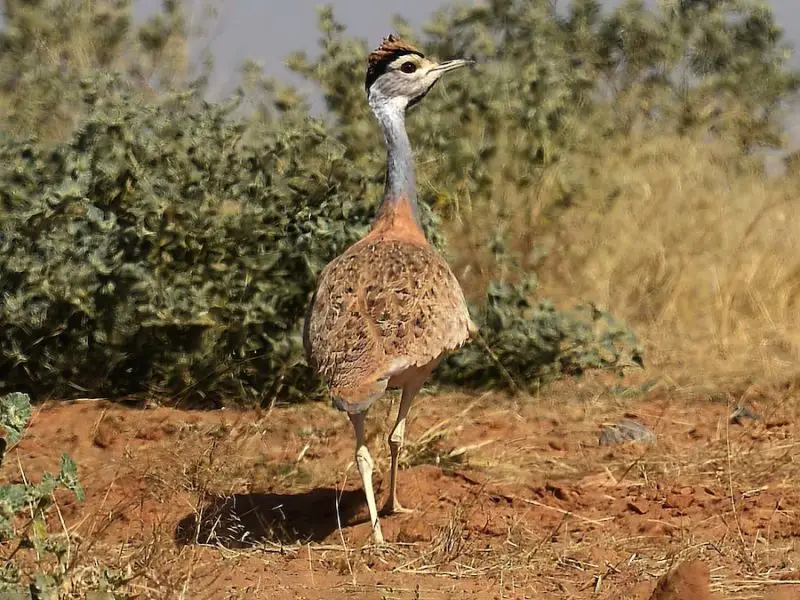
The Nubian Bustard is a large, ground-dwelling bird with a long neck, strong legs, and cryptic plumage in shades of brown and beige, which helps it blend with arid landscapes. Males are larger and more striking during courtship displays, often inflating their necks and strutting to attract females.
It inhabits dry savannas, semi-deserts, and open plains across northeastern Africa, including countries like Sudan and Ethiopia. This species prefers open habitats with sparse vegetation where it can forage and watch for predators.
Nubian Bustards are omnivorous, feeding on seeds, insects, small reptiles, and occasionally small mammals. They are shy and solitary birds, rarely seen in groups. An interesting fact is that despite their size, they are capable of strong flight, though they prefer to stay on the ground unless threatened.
Northern Shrike
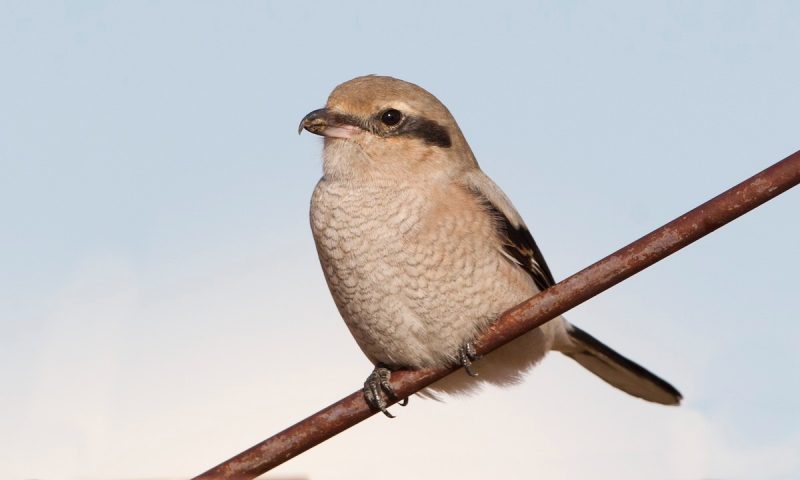
The Northern Shrike is a medium-sized songbird with a hooked beak, gray upperparts, black wings, and a black facial mask. Although it looks like a typical perching bird, it has raptor-like behaviors, using its beak to catch and kill prey.
This bird breeds in the taiga and boreal forests of the northern Northern Hemisphere, including parts of Canada, Alaska, and northern Eurasia. In winter, it migrates southward to open fields, shrublands, and farmlands.
Northern Shrikes feed on insects, small birds, rodents, and reptiles. They are infamous for impaling their prey on thorns or barbed wire—a behavior that helps them tear food into smaller pieces and store it for later. A surprising fact is that this behavior gives them the nickname “butcher birds.”
Noddy

The Noddy is a group of tropical seabirds known for their elegant, sleek appearance and gentle behavior. The most common is the Brown Noddy, which has chocolate-brown plumage and a white cap. They have long wings, slender bodies, and slightly forked tails.
Noddies are found on tropical and subtropical oceanic islands around the world, nesting in large colonies on coral atolls and rocky cliffs. They spend most of their lives at sea and come to land only to breed.
They feed on small fish and squid, which they catch by skimming the surface of the ocean. Noddies are known for their calm and trusting nature, often allowing close human approach. An interesting fact is that their name comes from their characteristic head-nodding display during courtship.
Northern Lapwing
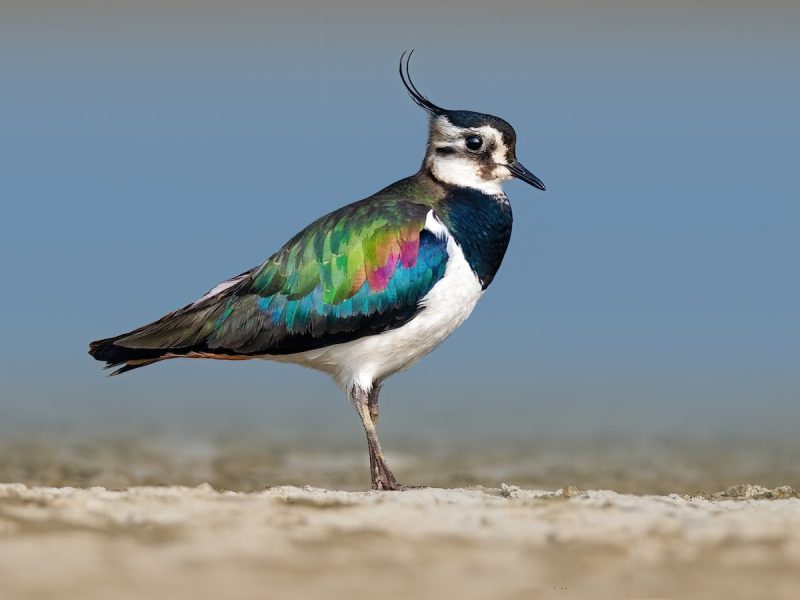
The Northern Lapwing is a striking bird with a rounded body, iridescent green-black upperparts, and a white belly. It is easily recognized by its long, wispy crest and slow, flapping flight. During the breeding season, males perform dramatic aerial displays to impress females.
It is found across Europe and Asia, typically inhabiting wetlands, farmlands, and grassy plains. In winter, many Northern Lapwings migrate to southern Europe, North Africa, and parts of the Middle East.
Their diet consists mainly of insects, worms, and other invertebrates found in soft soils and wet fields. They are ground nesters and will fiercely defend their nests from predators and intruders. A curious fact is that their distinctive call, “peewit,” gave rise to one of their alternative names—peewit.
Nile Crocodile
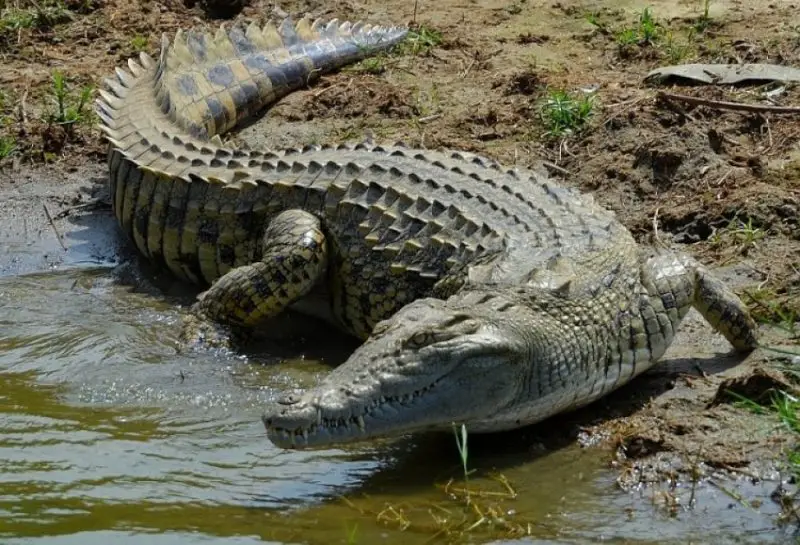
The Nile Crocodile is one of the largest crocodilian species in the world, with some males reaching over 16 feet in length. It has a robust body, armored skin covered with tough, scaly plates, and a powerful jaw filled with sharp conical teeth. Its coloration ranges from dark olive to brown, often helping it blend into murky waters.
This formidable reptile is widely distributed throughout sub-Saharan Africa, inhabiting rivers, lakes, swamps, and marshlands. It prefers freshwater environments but can occasionally tolerate brackish water. Nile Crocodiles are often seen basking on riverbanks or lurking near the surface with only their eyes and nostrils exposed.
They are opportunistic predators and scavengers, feeding on fish, birds, reptiles, and mammals, including large prey such as antelope and even buffalo. They use a “death roll” to dismember prey. A fascinating fact is that, despite their fearsome nature, Nile Crocodiles practice parental care by protecting their nests and sometimes carrying hatchlings in their mouths to water.
Northern Alligator Lizard

The Northern Alligator Lizard is a medium-sized lizard with a long, somewhat flattened body, short legs, and a tail that can be longer than its body. Its scales are keeled, and its coloration usually includes brown or grayish tones with darker crossbands. It resembles a miniature alligator, which inspired its name.
This lizard is native to the Pacific Northwest, ranging from British Columbia down through Washington, Oregon, and northern California. It lives in forests, woodlands, grassy slopes, and sometimes suburban gardens, often hiding under logs, rocks, or leaf litter.
Northern Alligator Lizards are carnivorous, eating insects, spiders, snails, and small vertebrates. They are known for their secretive behavior and ability to drop their tails as a defense mechanism. An interesting fact is that these lizards give birth to live young rather than laying eggs—a relatively rare trait among reptiles.
Newt
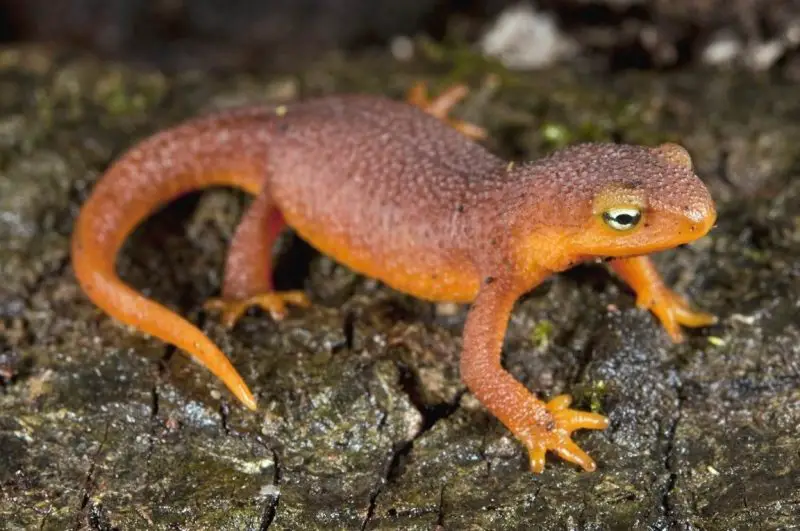
Newts are a group of semi-aquatic salamanders known for their smooth, moist skin, long tails, and distinct life cycle that includes both aquatic and terrestrial stages. They typically have bright coloration during the breeding season, especially the males, which can develop crests or vivid stripes.
They are found in North America, Europe, and Asia, usually in moist woodlands, meadows, and ponds. Newts return to freshwater ponds and streams during the breeding season and may migrate long distances to reach their breeding sites.
Newts feed on insects, worms, and small aquatic creatures. They are skilled swimmers and use their tail for propulsion. A cool fact about newts is that they can regenerate lost limbs, tails, and even parts of their heart or eyes, making them a major subject of scientific study in regeneration research.
Northern Leopard Frog
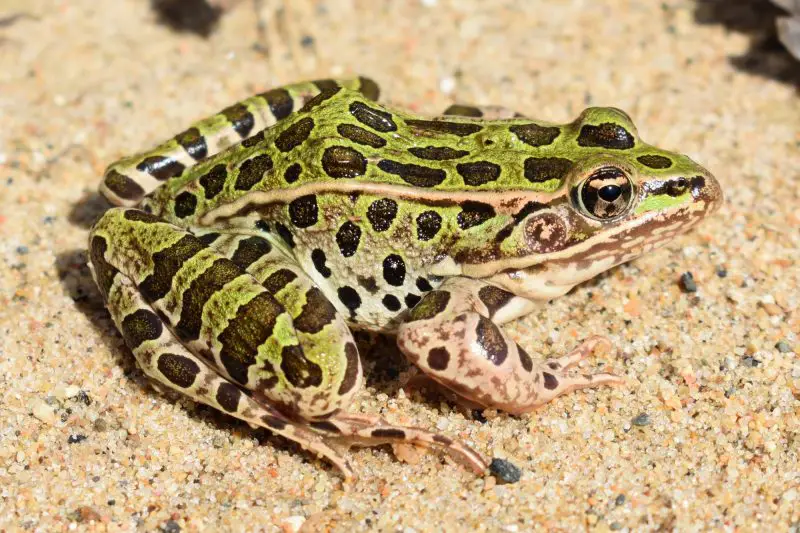
The Northern Leopard Frog is a medium-sized frog with a slender body and long legs, easily recognized by its green or brown coloration with dark, round spots resembling a leopard’s pattern. It has a white belly and a distinctive pair of dorsolateral folds running from its eyes down its back.
This species is native to much of North America, particularly in Canada and the northern United States. It inhabits ponds, lakes, slow-moving streams, and grassy meadows. During winter, it hibernates at the bottom of water bodies, often buried in the mud.
Northern Leopard Frogs are insectivores, feeding on beetles, flies, ants, and even small birds or snakes when available. They are known for their quick, powerful jumps. A fun fact is that this frog was once widely used in biological research and in classroom dissection, but its population has declined in some regions due to habitat loss and disease.
Northern Tree Frog
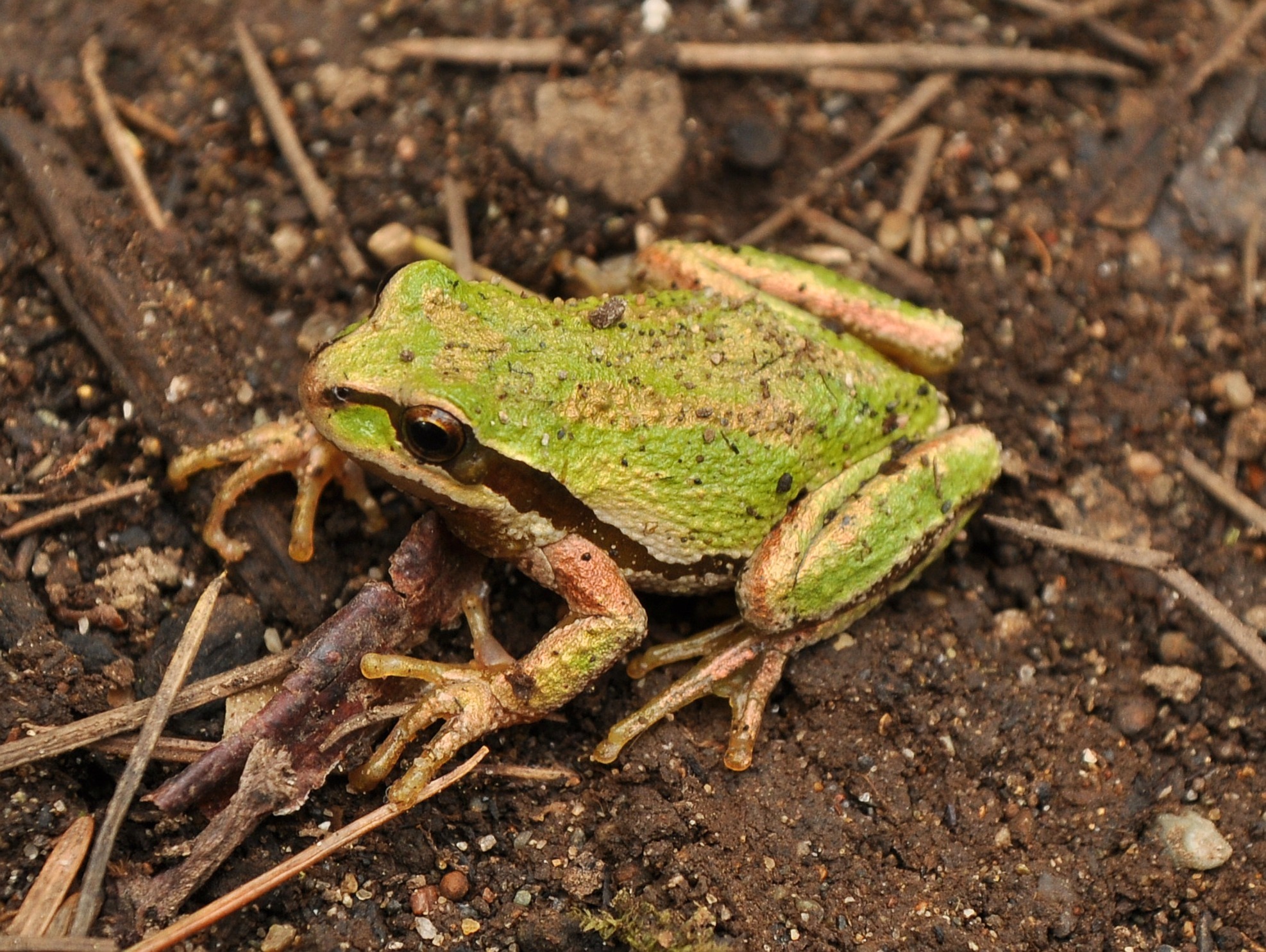
The Northern Tree Frog, also known as the Gray Tree Frog, is a small amphibian with the remarkable ability to change its color from gray to green to match its surroundings. It has a warty texture and large toe pads that help it cling to branches and leaves.
It is commonly found in forests and woodlands of the eastern United States and southeastern Canada. These frogs spend most of their time in trees or shrubs but descend to shallow water bodies to breed in spring and early summer.
They eat insects, spiders, and other small invertebrates. Northern Tree Frogs are nocturnal and are known for their distinctive musical trills during mating season. An amazing fact is that they can survive being frozen in winter by producing glycerol, a natural antifreeze that protects their organs during hibernation.
Night Snake
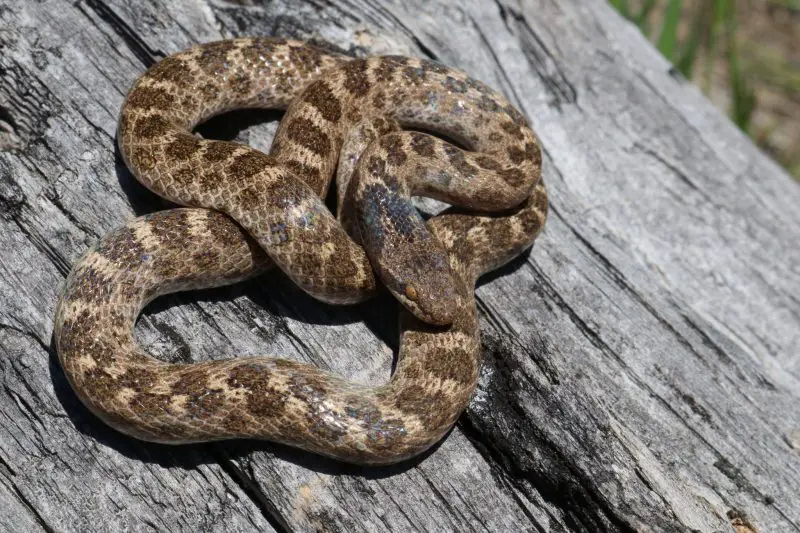
The Night Snake is a small, secretive snake with smooth scales and a pale gray, light brown, or cream-colored body marked with darker blotches down its back. It has a slightly flattened head with vertical pupils, giving it a cat-like appearance.
Native to the western United States, Mexico, and parts of British Columbia, the Night Snake prefers dry, rocky habitats such as deserts, grasslands, and open woodlands. It is primarily nocturnal, which helps it avoid extreme daytime heat.
This snake feeds on lizards, amphibians, and small rodents, using mild venom in its rear fangs to subdue prey—though it poses no threat to humans. A fascinating fact is that despite its venom, it’s considered completely harmless and is often overlooked due to its elusive, nighttime habits.
Nurse Shark

The Nurse Shark is a large, slow-moving species of shark with a broad, flattened head and a characteristic pair of barbels near its nostrils, which it uses to sense food in the sand. It has a light brown or grayish body with darker spots and a long, thick tail. Despite its intimidating size, the Nurse Shark is generally harmless to humans.
It is found in warm, shallow waters of the western Atlantic, including the Gulf of Mexico and the Caribbean Sea. Nurse Sharks prefer coral reefs, mangrove swamps, and sandy areas near shore. They are often seen resting on the sea floor during the day and become more active at night when they hunt.
Nurse Sharks are opportunistic feeders, preying on fish, crustaceans, mollusks, and even small rays. They are bottom-dwelling sharks and often hunt by using their barbels to locate prey hidden in the sand. An interesting fact is that Nurse Sharks are known for their ability to breathe while stationary, using a specialized muscle to pump water over their gills.
Nile Perch
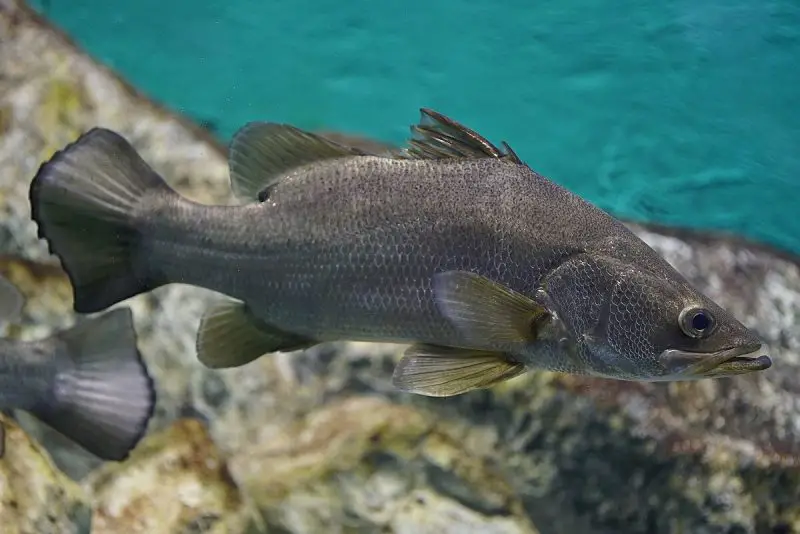
The Nile Perch is a large, predatory freshwater fish that can grow up to 6.6 feet in length and weigh over 500 pounds. It has a robust body with silver-gray scales and a large mouth, filled with sharp teeth. This species is notable for its aggressive nature and predatory feeding habits.
Native to the Nile River and parts of Africa, it has been introduced to other freshwater bodies, such as Lake Victoria. The Nile Perch prefers deep, slow-moving waters and can thrive in various aquatic habitats, including rivers, lakes, and reservoirs.
As a carnivore, the Nile Perch feeds on smaller fish, invertebrates, and even amphibians. It has been both a vital food source for people in Africa and a major invasive species in Lake Victoria, where it has had a significant impact on local ecosystems. A fascinating fact is that the Nile Perch’s introduction to Lake Victoria led to the near extinction of several native fish species.
Northern Pike

The Northern Pike is a large, predatory fish with a long, slender body and a sharp, elongated snout. Its dark green to grayish coloration is often patterned with light spots, helping it blend in with aquatic vegetation. Known for its fierce hunting style, the Northern Pike has a row of sharp teeth that allow it to capture prey.
It inhabits freshwater lakes, rivers, and ponds across North America, Europe, and parts of Asia. Northern Pike are typically found in shallow waters near aquatic plants, which they use as cover while hunting. They prefer cooler waters and can survive in both clear and murky environments.
Northern Pike are carnivorous, feeding on smaller fish, frogs, and even waterfowl. They are ambush predators, waiting motionless for prey to pass by before striking with incredible speed. A fun fact is that Northern Pike are known for their aggressive feeding behavior, and they can grow to be quite large, with some individuals reaching over 40 inches in length.
Napoleon Wrasse
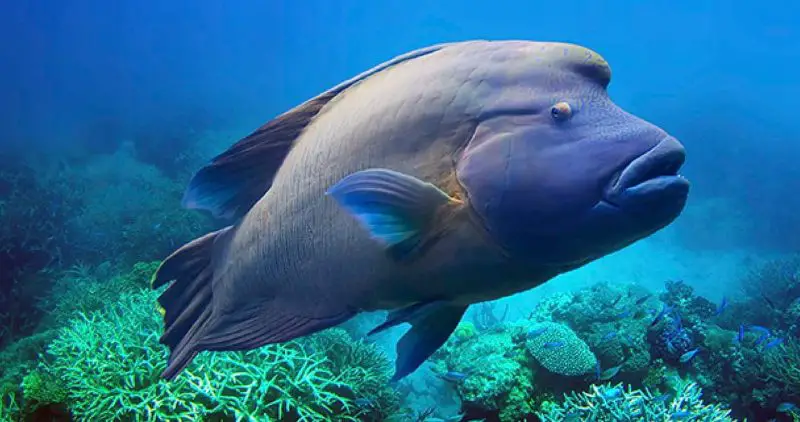
The Napoleon Wrasse is a large, colorful fish with a prominent hump on its forehead, which becomes more pronounced as it ages. Its scales are a vibrant mix of blue, green, and purple, and it can grow up to 6.5 feet in length. This species is easily recognizable by its thick lips and large size.
Native to coral reefs in the Indo-Pacific region, including the Great Barrier Reef and around Southeast Asia, Napoleon Wrasse prefers shallow waters and can be found at depths of up to 100 feet. These fish are often seen near coral formations or rocky outcrops.
Napoleon Wrasse are carnivorous, feeding on a variety of invertebrates, including mollusks, crustaceans, and sea urchins, as well as smaller fish. They have powerful jaws and can crush hard-shelled prey. An interesting fact is that the Napoleon Wrasse is a vulnerable species, and its population is declining due to overfishing and habitat destruction.
Noodlefish
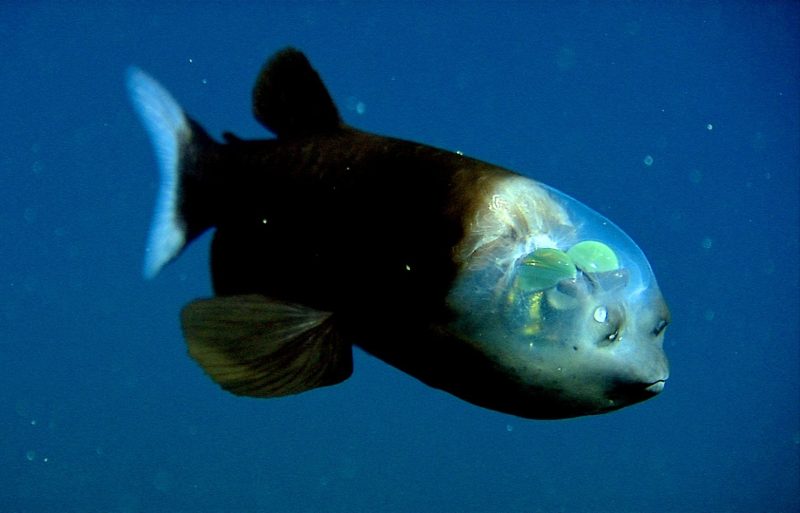
The Noodlefish, or Barreleye Fish, is a small, deep-sea species with a long, slender body and a transparent, gelatinous appearance. Its most distinctive feature is its large, tubular eyes that can rotate inside its head, enabling it to detect faint light from bioluminescent organisms in the deep ocean. Its pale greenish or brownish body allows it to blend in with its surroundings.
Noodlefish inhabit the deep, dark waters of the Pacific Ocean, often at depths ranging from 500 to 2,000 feet. They are primarily found off the coast of Japan, but their range also extends to other parts of the western Pacific. Due to their deep habitat, little is known about their full range and behavior.
They feed primarily on plankton, small fish, and invertebrates that drift in the water column. Their large, rotatable eyes are adapted for hunting in the dimly lit waters of the deep ocean. An interesting fact is that Noodlefish’s transparent bodies help them avoid predators, making them virtually invisible to larger marine creatures.
Ninespine Stickleback
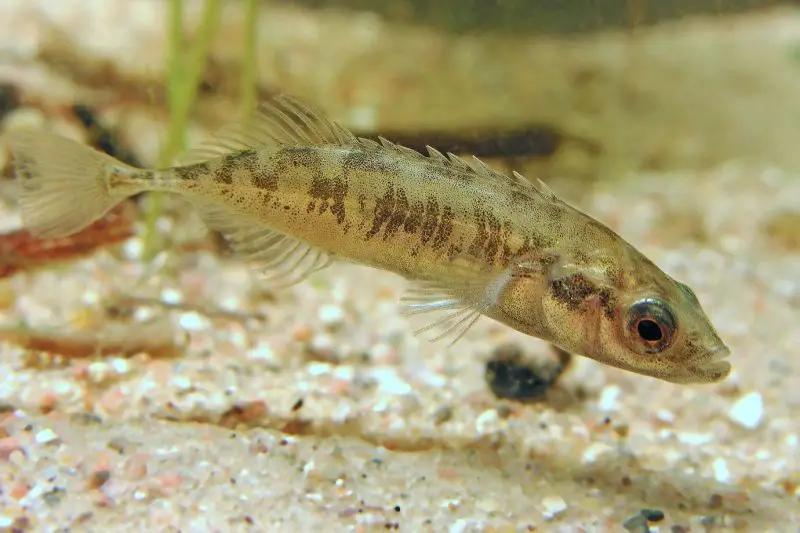
The Ninespine Stickleback is a small fish with a slender body and distinct, sharp spines along its back, giving it its name. It has a shiny silver body with a dark lateral stripe running from head to tail. These fish are generally less than 3 inches in length, with males often developing bright colors during the breeding season.
This species is found in freshwater lakes, ponds, and coastal waters across North America, Europe, and parts of Asia. The Ninespine Stickleback prefers shallow, weedy areas where it can hide from predators and find food. They are also known to migrate between saltwater and freshwater environments depending on the season.
Ninespine Sticklebacks are opportunistic feeders, primarily eating small invertebrates, zooplankton, and insect larvae. They are known for their intricate courtship displays during mating season, where males build elaborate nests and display their bright colors to attract females. A fun fact is that Ninespine Sticklebacks are commonly used in scientific research due to their unique adaptability to both saltwater and freshwater environments.
Notothen (Antarctic Toothfish)
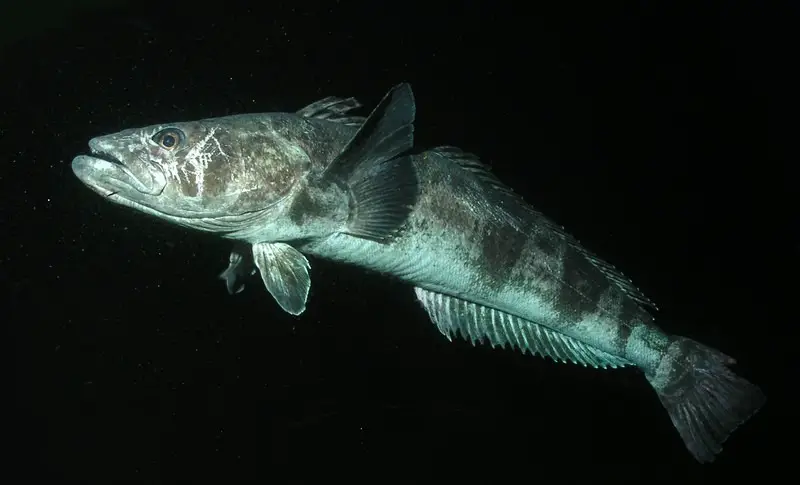
The Notothen, also known as the Antarctic Toothfish, is a large, predatory fish found in the icy waters surrounding Antarctica. It has a white, smooth body with sharp, backward-facing teeth. It can grow to over 8 feet in length and weigh up to 200 pounds, making it one of the largest fish species in the Southern Ocean.
This species is native to the Southern Ocean, primarily around Antarctica, and is found at depths of up to 5,000 feet. It prefers the cold, deep waters beneath the ice shelves, where the temperature hovers around freezing, and has adapted to these conditions by producing antifreeze proteins to prevent its blood from freezing.
Notothen is a carnivorous fish that feeds on smaller fish, squid, and krill. It is an important part of the Antarctic food web, as it serves as prey for larger predators like seals and whales. An interesting fact is that Notothen’s antifreeze proteins have been a subject of scientific study, as they are being explored for use in human medical applications, such as preserving organ transplants.
Nautilus
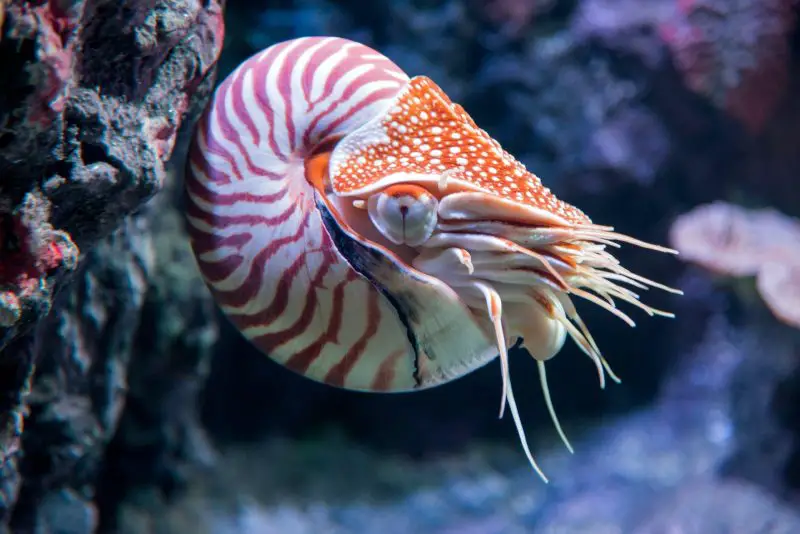
The Nautilus is a marine cephalopod with a spiral-shaped shell that can grow up to 10 inches in diameter. Its soft body is housed inside a gas-filled chamber, which allows it to regulate its buoyancy and move up and down in the water column. The Nautilus has numerous tentacles, though it lacks the suction cups typical of other cephalopods.
Nautiluses are primarily found in the warm, deep waters of the Pacific and Indian Oceans, particularly around coral reefs and deep-sea regions. They prefer the sloping underwater ridges and are usually found at depths of 300 to 500 meters, though they occasionally venture closer to the surface.
They are scavengers, feeding on fish, crustaceans, and dead animals they find on the ocean floor. Nautiluses have been around for over 500 million years, making them one of the oldest surviving species of cephalopods. A fascinating fact is that despite their ancient lineage, Nautiluses are not considered “intelligent” like other cephalopods, as their behavior is more instinctual.
Net-winged Beetle

The Net-winged Beetle is a striking insect known for its delicate, net-like wings and vibrant coloration, which can range from red to orange or yellow. Its body is elongated, and it has large, round eyes. The net-like appearance of its wings is one of its most distinctive features, and it is often seen flying in gardens and wooded areas.
Native to North America, the Net-winged Beetle is commonly found in moist habitats such as forests, meadows, and gardens. It prefers areas with plenty of vegetation, where it can feed on various plant materials and detritus. The beetle is especially active during the warmer months, often seen on sunny days.
This beetle is not a significant threat to plants, as it feeds on decomposing matter, fungi, and smaller insects. Some species of Net-winged Beetles produce chemicals that make them distasteful to predators, and they are often brightly colored to signal their toxicity. An interesting fact is that these beetles are often mistaken for fireflies, but they do not produce light.
Northern Walkingstick
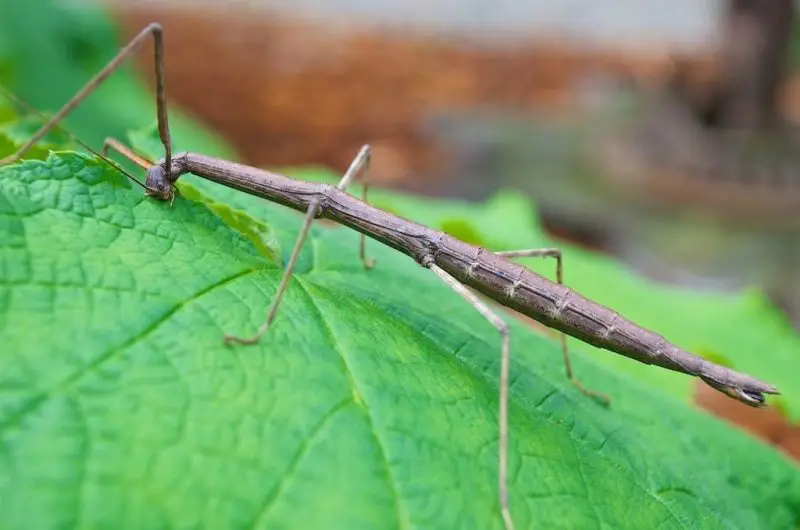
The Northern Walkingstick is an insect that resembles a twig or branch, which helps it blend into its environment. It has long, thin legs and a narrow body, which makes it a master of camouflage. Its color can vary from brown to green, depending on its environment, and it can grow up to 6 inches in length.
This species is found in temperate forests across North America, where it lives in trees and shrubs. The Northern Walkingstick is most commonly seen in areas with abundant vegetation, as its diet primarily consists of leaves from various trees and plants.
Northern Walkingsticks are herbivores, feeding on the leaves of trees such as oak and willow. They use their excellent camouflage to avoid predators, relying on their stillness to remain unnoticed. A fun fact is that when threatened, the Northern Walkingstick may sway its body to mimic the movement of a plant in the wind, further enhancing its disguise.
Nose-horned Viper
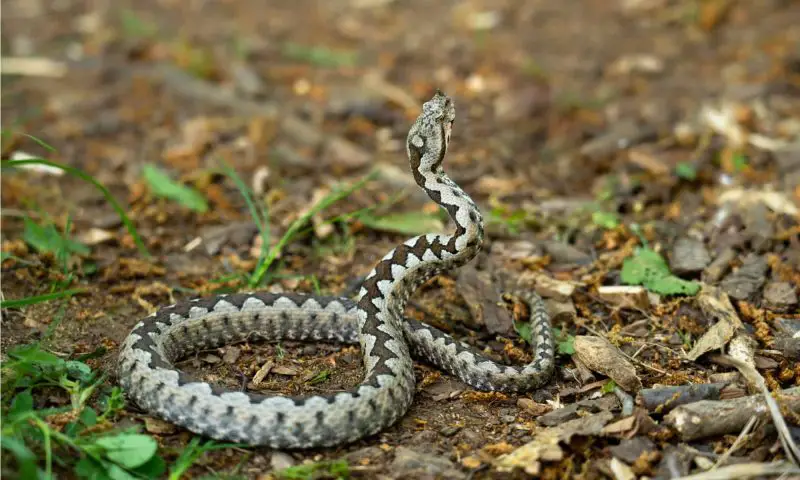
The Nose-horned Viper is a venomous snake known for the horn-like structure on its nose, which is formed by a modified scale. This unique feature gives the viper its name and is used in courtship displays. Its coloration ranges from gray to brown with darker markings, helping it blend into the rocky and wooded areas it inhabits.
This snake is found in parts of Europe, particularly in southern regions such as Spain, Greece, and Turkey. It prefers dry, rocky habitats, mountain slopes, and scrublands, where it can easily find shelter among rocks and undergrowth. The Nose-horned Viper is a terrestrial species but can be found at elevations up to 2,000 meters.
As a carnivore, it feeds on small mammals, birds, and reptiles, using its venom to immobilize prey. The venom of the Nose-horned Viper is potent but rarely deadly to humans. A fascinating fact is that these snakes are known for their cryptic behavior, often lying motionless for long periods, making them difficult to spot in their natural habitat.
Northern Paper Wasp
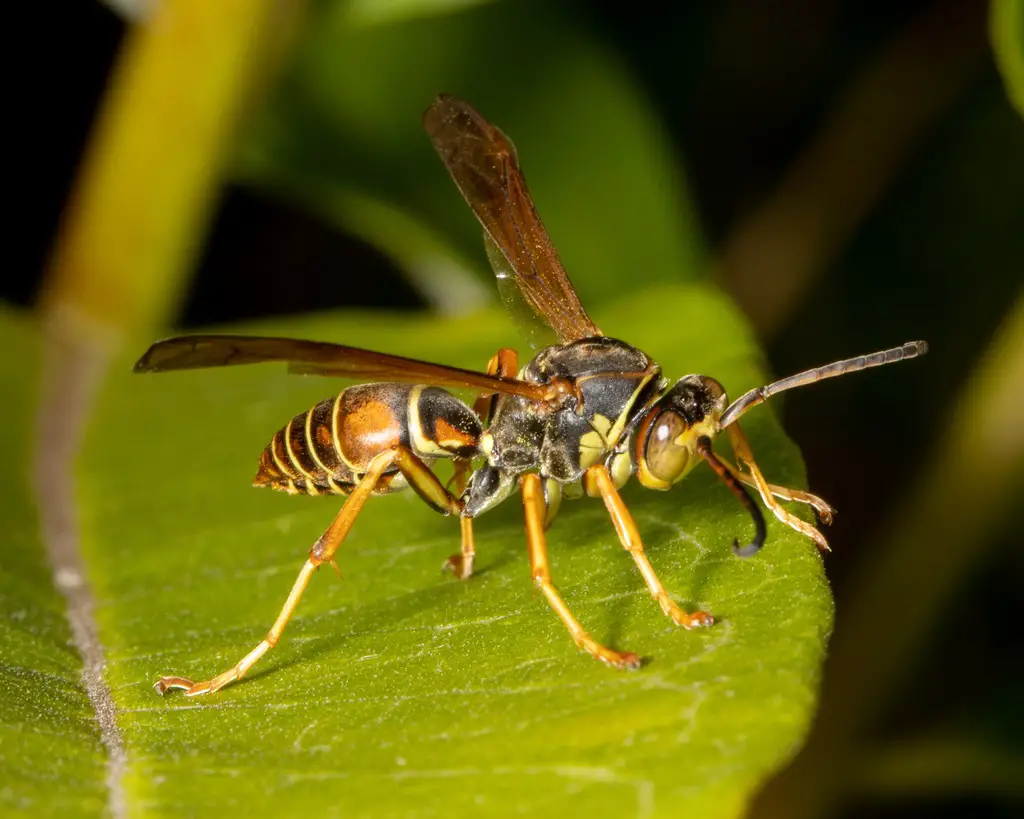
The Northern Paper Wasp is a species of wasp that is easily recognizable by its slender, yellow, and black body and its papery, gray nests. The nests are usually constructed under the eaves of buildings, in trees, or in shrubs, and can grow quite large during the summer months.
This wasp is found in the northeastern and central United States, often in gardens and wooded areas. The Northern Paper Wasp prefers to nest in sheltered, elevated locations, where it can build its intricate paper nests. It is most active in warm months, particularly from spring to fall.
Northern Paper Wasps are omnivorous, feeding on nectar, fruit, and small insects. While they are less aggressive than other wasp species, they will defend their nests if threatened. A fun fact is that despite their reputation, these wasps are beneficial to gardens because they help control pest insect populations.
Northern Coral Snake
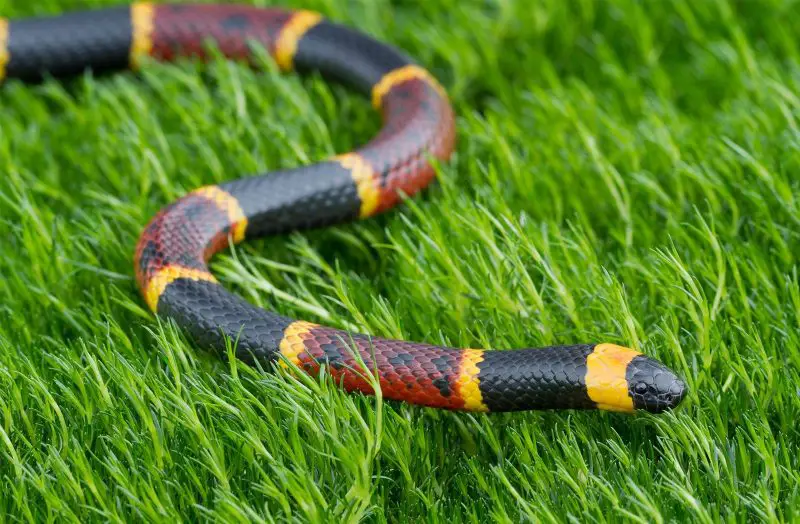
The Northern Coral Snake is a highly venomous snake known for its distinctive coloration, with alternating bands of red, yellow, and black. Its small size, typically only 1 to 2 feet in length, and its striking pattern make it easily identifiable, though it is often confused with the non-venomous scarlet kingsnake.
Native to the southeastern United States, the Northern Coral Snake prefers forests, grasslands, and sandy areas with plenty of cover. It is often found in the underbrush or buried in leaf litter, where it hunts for small prey. This species is most active during the warmer months.
It feeds primarily on small reptiles, amphibians, and other snakes. The Northern Coral Snake’s venom is potent and neurotoxic, but it is typically shy and reclusive, rarely posing a danger to humans. An interesting fact is that despite their venomous nature, Northern Coral Snakes have a relatively low incidence of bites on humans due to their tendency to avoid confrontation.
Northern Potoo
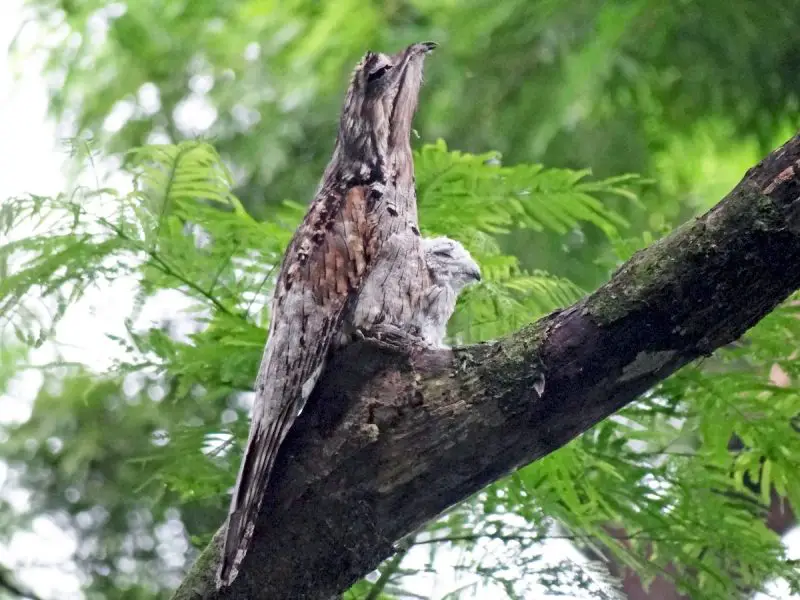
The Northern Potoo is a nocturnal bird with a large, bulbous head and large eyes, ideal for its night-hunting habits. Its plumage is mottled with gray and brown, which helps it blend seamlessly into tree branches, making it a master of camouflage. Its wide, gaping mouth is used to catch insects mid-flight.
This bird is found in the forests and woodlands of Central and South America, particularly in countries like Mexico, Costa Rica, and Panama. It prefers habitats with dense foliage, where it can remain hidden during the day and hunt at night. The Northern Potoo is often perched on exposed tree branches, where it remains motionless during the day.
The Northern Potoo feeds on insects, primarily moths and beetles, which it catches during its nightly flights. It hunts by swooping down with its large mouth wide open to capture prey. A fascinating fact is that the Northern Potoo’s calls, which sound like a mournful whistle, are often heard at night and are thought to communicate territorial boundaries.

